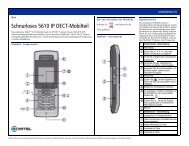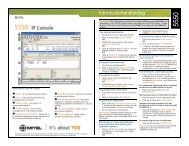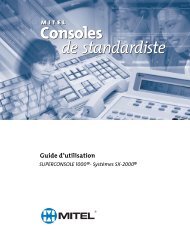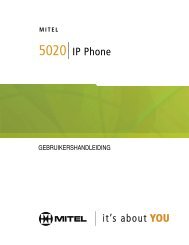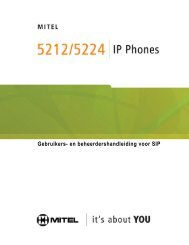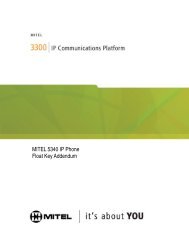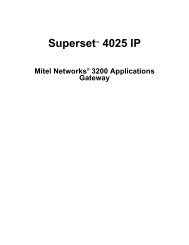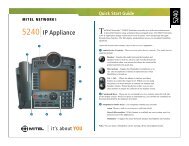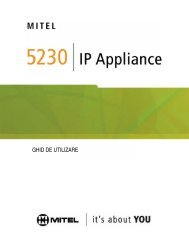User Guide for 3050 ICP Users - Mitel Edocs
User Guide for 3050 ICP Users - Mitel Edocs
User Guide for 3050 ICP Users - Mitel Edocs
Create successful ePaper yourself
Turn your PDF publications into a flip-book with our unique Google optimized e-Paper software.
- 67 -<br />
Appendix C—Configuration Files<br />
Appendix C—Configuration Files<br />
Example of a Generic Configuration File<br />
# <strong>Mitel</strong> 5055 SIP Phone Generic Configuration File<br />
# this file name= SIPGeneric.cfg<br />
# Grammar=<br />
# comment lines start with a'#'<br />
# no escape '\' continue lines are allowed. No escape character is allowed.<br />
# the string length of a parameter must be less than 128 characters<br />
# parameter template=<br />
# token = parameter ; comments<br />
# if the setting is configurable using Web Configuration Tool, the location of that<br />
# setting is shown in parentheses)<br />
########################################################################<br />
# System Configuration Begins Here<br />
########################################################################<br />
# IMAGE VERSION<br />
# The image and boot version values are used to verify if the phone has the latest<br />
# software. This value should match the version number of the software on the TFTP<br />
# server.<br />
image_version= 1.0.1.46 ; Main image (software) version number<br />
boot_version= 1.0.1.46 ; boot image (software) version number<br />
# If needed, change the image name value to match the main software filename.<br />
image_name= ipp5055main.bin<br />
# CONFIGURE THE PHONE BY THE TFTP SERVER<br />
# (Network Configuration, Advanced, TFTP Configuration)<br />
# choice [0-no, 1- yes, 2-always]<br />
# if the option "always" is chosen, every time the phone boots up, it downloads<br />
# the configuration parameters from the TFTP server which overwrites any static<br />
# values of these parameters. This mode is useful <strong>for</strong> administrators to control the<br />
# phone's settings. <strong>User</strong> can't select this option from the web interface.<br />
# If the option "Yes" is chosen, the phone will boot up and download the configuration<br />
# file from the TFTP server. There<strong>for</strong>e, the statically configured parameters, if any,<br />
# are overwritten by the parameters in the configuration file. After boot up, user can<br />
# change this parameter to "No" from web interface.<br />
# If the option "No" is chosen, the phone, when booting up, does<br />
# not download the configuration file from the TFTP server. The phone may only<br />
# do a version check <strong>for</strong> the main image.<br />
tftp_config= 1<br />
# ADDRESS TYPE<br />
# (Network Configuration, Basic, Address Type)<br />
# choice[0-IPv4 or 2-FQDN],<br />
# when the option IPv4 is chosen, the outgoing SIP requests uses the dotted<br />
# <strong>for</strong>mat of the IP address<br />
# when FQDN is chosen, the outgoing SIP requests uses the "sip:host_name.domain" <strong>for</strong>mat<br />
# <strong>for</strong> the "contact" SIP header. The FQDN address must be a resolvable entry in the DNS<br />
# server.<br />
addr_type= 0<br />
# DOMAIN NAME<br />
# (Network Configuration, Basic, Domain Name)<br />
domain= -example.com<br />
# TFTP SERVER IP ADDRESS<br />
# (Network Configuration, Additional Servers, TFTP server)<br />
# the SIP phone downloads the boot image, the main image, and the configuration<br />
# parameters from this IP address<br />
tftp= 192.168.0.1




